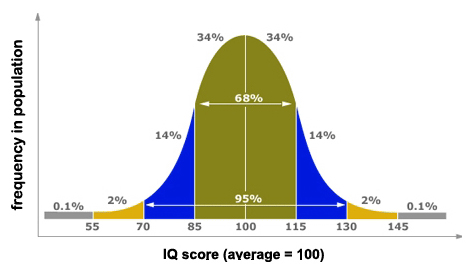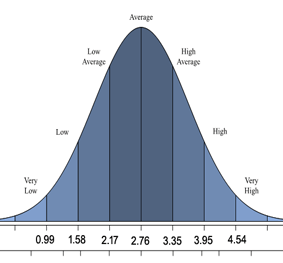The Bell Curve was a seminal work on IQ and its impact in society, published in 1994 by psychologist Richard J. Herrnstein and libertarian political scientist Charles Murray.
Its central argument is that human intelligence, measured by IQ tests, is influenced substantially by both inherited and environmental factors, and IQ is better predictor of financial income, job performance, and involvement in crime than are parental socioeconomic status or education level.
Another thesis of The Bell Curve is that those with high intelligence, the “cognitive elite”, are becoming increasingly separated from those of average and below-average intelligence – and that this has important social implications.

This claim is supported by the facts. Here is a ‘bell curve’ distribution of IQ scores in the general US population. It is called a bell curve because of its bell shape. It has a similar shape for all populations in which IQ has been measured.
This curve tells us that the average IQ score is 100, and about 95% of the population have an IQ score (measured by a valid IQ test) somewhere between 70 and 130. 68% have an IQ level between 85 and 115. Each 15 IQ point interval is called one standard deviation – so we can say that 95% of the population have an IQ between -2 and +2 standard deviations from 100. Mensa requires an IQ of 130 which puts you in the top 2% of the population.
Now look at this data on college students, based on SAT scores. First, going back to 1930 (translating back from standard deviations to IQ scores!) you can see that the average IQ of all college graduates was 111. The average IQ of Ivy League colleges was 120. That’s not that different.
But if we jump forward to 1990, just before The Bell Curve was written, you see a very different picture.
While the average IQ of all college graduates in the country has barely changed (from 111 to 113), the average IQ of Ivy League college graduates has increased from 120 to 142. That’s an extraordinary gain.
The mean of the elite 12 universities in the US rose to over 140.
Refer to the bell curve above to see just how ‘off the curve’ that is.
That was back in 1990. Now the IQ level may be even greater, assuming it has not reached close to its natural limit – as we find in elite athletes.
Mainstream science on intelligence: The 1994 IQ manifesto by IQ Experts
The Bell Curve was controversial, and generated a lot of inaccurate and misleading public reports and discussion about IQ. To counter these reports an IQ manifesto was issued in the Wall Street Journal in December 1994, signed by 52 professors specializing in intelligence and related fields, including around one third of the editorial board of the journal Intelligence. This IQ manifesto – called ‘Mainstream Science on Intelligence’ represents the findings widely accepted in the expert community in 1994. We have come on since then in our understanding of IQ considerably but these points are still accepted and provide a good starting point for our current understanding.

18 conclusions on intelligence and IQ scores
The following 18 conclusions are taken from Mainstream Science on Intelligence (1994):
- “Intelligence is a very general mental capability … it reflects a broader and deeper capability for comprehending our surroundings …”
- “Intelligence, so defined, can be measured, and intelligence tests measure it well. They are among the most accurate (in technical terms, reliable and valid) of all psychological tests and assessments.”
- “While there are different types of intelligence tests, they all measure the same intelligence.”
- “The spread of people along the IQ continuum … can be represented well by the … ‘normal curve’.”
- “Members of all racial-ethnic groups can be found at every IQ level”
- “IQ is strongly related, probably more so than any other single measurable human trait, to many important educational, occupational, economic, and social outcomes … Whatever IQ tests measure, it is of great practical and social importance”
- “A high IQ is an advantage because virtually all activities require some reasoning and decision-making”
- “The practical advantages of having a higher IQ increase as life’s settings become more complex”
- “Differences in intelligence certainly are not the only factor affecting performance in education, training, and complex jobs … but intelligence is often the most important”
- “Certain personality traits, special talents, [etc] are important … in many jobs, but they have narrower (or unknown) applicability or ‘transferability’ across tasks and settings compared with general intelligence”
- “Heritability estimates range from 40% to 80%.”
- “Members of the same family also tend to differ substantially in intelligence”
- “Genetically caused differences are not necessarily irremediable”
How has expert opinion been revised since 1990?
Heritability estimates show that between 20% and 60% of individual differences in IQ are due to environmental influences, including education, diet and training.
What is also becoming apparent is that IQ and problem-solving IQ training – such as you find in elite universities – strongly interact. A higher IQ may give you entry to an elite university, which in turn provides a training environment to develop cognitive skills and strategies, raising the student’s IQ even further. There is a ‘virtuous circle’ effect. IQ levels on entering Harvard may be 10 or more points lower than IQ levels on leaving Harvard.
The opposite is the case for children who graduate from high school and end up in environments that do not stimulate their minds. Their IQ levels could – over a four year period – drop from high IQs of 115 or more to average levels.


